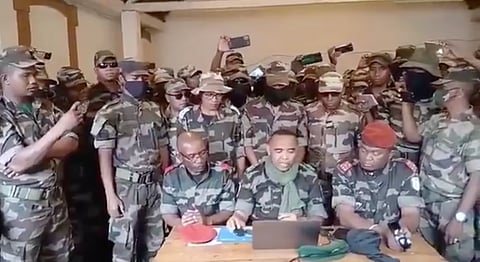

Protests in Madagascar reached a dramatic turning point on Saturday when demonstrators entered the symbolically charged May 13 Square in Antananarivo for the first time since the unrest began last month, accompanied by a military escort.
The youth-led movement, which started on September 25 over chronic water and electricity shortages, has broadened into a major challenge to President Andry Rajoelina's leadership, the most significant since his re-election in 2023.
The demonstrations drew thousands to the capital, marking one of the largest gatherings in recent days.
Inspired by Gen Z movements in Kenya and Nepal, the protests have evolved into demands for Rajoelina's resignation, an apology to the nation, and the dissolution of the senate and electoral commission.
A pivotal development unfolded when members of the elite CAPSAT unit, which supported Rajoelina's 2009 coup, publicly urged fellow soldiers to disobey orders and align with the protesters.
Videos on social media captured CAPSAT troops calling on colleagues to "support the people" and join forces with demonstrators, gendarmes, and police.
"Let us join forces, military, gendarmes and police, and refuse to be paid to shoot our friends, our brothers and our sisters," the soldiers stated in a video from the Soanierana district base.
They further instructed troops at the airport to prevent aircraft departures and those in other camps to close gates and await instructions, emphasizing refusal to fire on comrades.
Some soldiers left barracks to escort protesters into May 13 Square, a site of past political uprisings that had been off-limits and heavily guarded.
Near Lake Anosy, arriving troops were met with cheers and cries of "Thank you!" as they waved Madagascar flags, following police use of stun grenades and tear gas to disperse crowds.
Military leaders responded by promoting dialogue.
The chief of staff and a senior Ministry of the Armed Forces official called for troops to engage in discussions.
Newly appointed Minister General Deramasinjaka Manantsoa Rakotoarivelo urged calm, stating, "We call on our brothers who disagree with us to prioritise dialogue."
He added, "The Malagasy army remains a mediator and constitutes the nation's last line of defence."
The unrest has turned violent, with security forces deploying tear gas, rubber bullets, and armored vehicles.
On Thursday, several protesters were injured in dispersals, and videos of police beatings, including one man left unconscious, spread widely online.
The United Nations reported at least 22 deaths and 100 injuries since the protests' outset, urging authorities to avoid unnecessary force and protect rights to assembly.
Rajoelina has contested the figures, claiming 12 deaths among looters and vandals.
Initially conciliatory, he dismissed his cabinet last week and appointed a military officer as prime minister on October 6.
His new cabinet includes figures from the armed forces, public security, and armed police, signaling a hardened stance against further disturbances.
Madagascar, among the world's poorest nations, has a history of uprisings since independence in 1960, including the 2009 protests that elevated Rajoelina to power after ousting his predecessor.